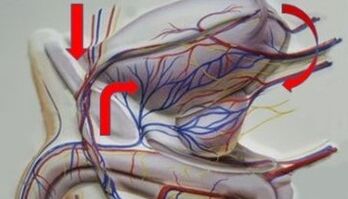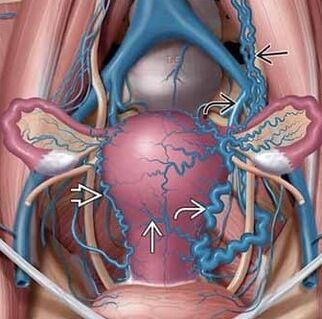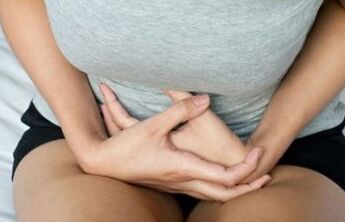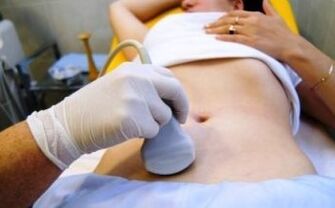The pelvic vein (WRMW) or chronic pelvic pain syndrome is still an exotic disease with blurred diagnostic border for many doctors.
This explains the fact that some doctors "do not notice" the disease for their patients for a long time, while others make this diagnosis almost every second person suffering from pain that cannot be described in the lower abdomen.

Meanwhile, the quality of life of the patient, his ability to enjoy intimate relationships with loved ones and the ability to continue his family, largely depends on timely detection of varicose veins, largely dependent.
Description of illness, prevalence, statistical data
The phenomenon of chronic pelvic pain has been known to the doctor for a long time. But just recently it is the most possible cause - pelvic varicose veins. This is a diseaseFirst described in 1975And still not studying well.
Most likely this pathology develops according to the following algorithms:
- The venous plexus in the pelvis is a complex formation, which includes both large vascular stems and smaller veins than them. At the same time, the small pelvic vein system in men and women differ in its structure, which determines the sexual specifications of the disease - VRVMTMore common in representatives of weaker sex.
- Due to the vessels of the vessels, complete blockage or part of the venous tract, changes in the vascular wall tone are interrupted by blood flow from deep pelvic veins.
- As a result, the veins stop fully fulfilling their function:The lack of vein valve lastsAnd normal blood flow is interrupted.
- In the pelvic vein, the stagnant phenomenon associated with the blood vessels through the vessels begins - this causes the development of veins and the development of varicose veins.

Symptoms of varicose veins (varicose) of the pelvic internal organs are more common in women of reproductive age than men. At the same time, the ovarial veins ("ovaries") suffer most often - in 85% of cases.
The main symptoms are pain recorded in more than 90% of patients. But the prevalence of the disease among the population has not been explained: according to different studies, it is from 6 to 80%. A large run in "testimony" is explained only by inadequate qualifications of the diagnostic doctor when making a diagnosis.
Cause and risk factors
The cause of pelvic varicose veins is any change in the body that can trigger the launch of the pathological mechanism of the disease:
| The cause of the anatomy and physiology of varicose veins | What can lead to this |
| Mechanical compression of the pelvic vein |
|
| Changed the tone of the blood vessels |
|
| Wrapping the pelvic veins |
|
VRVMT high risk factors are:
- tense physical work;
- inadequate or unsatisfactory sex life;
- abuse in intimate life by disturbed sexual relations;
- Most of the pregnancy and childbirth;
- frequent gynecological disease;
- contraception with hormone drugs;
- hormone damage in the body;
- Hypodynamia.
Classification and level of varicose veins
In the medical environment, VRVMT conditional separation is accepted by the nature of the course into varicose veins from external curvature and genitals (for example, labia) and pletora venous syndrome.
This classification does not have much practical importance, becauseIn most cases, the patient has both formsAt the same time, such as provoking each other.
You can also find the classification of the disease with the root cause of its appearance. In this case, VRVMT is divided into:
- Predominant- due to unsatisfactory work of the vein valve;
- secondary- develops as a complication of inflammatory, gynecological or oncology diseases for the internal organs.

What is dangerous and whether there will be a consequence
This type of vascular pathologycannot be called a deadly disease. Found in time, it lends itself well to medical correction. But the whole problem is that it is not easy. Insufficient knowledge of the disease and low awareness of most diagnostic doctors plays a role in this regard.
Therefore, it turns out that the patient had suffered the disease for years without suspecting. And in their bodies, whileThere are some irreversible changes:
- Varicosis lasts, adjacent areas are included in the pathological process - the development of reproductive organs (for example, penile varicose veins), perineum and lower legs appear.
- Continuous dysfunction of an internal genital organs appear, whichmay cause infertility or inability to withstand pregnancyIn women.
- Against the background of the pain syndrome, various psycho -anemotional disorders by neurasthenia type develop.
- Due to chronic pain, aggravating during intimacy, one may leave sex completely.
- The rarest and at the same time the worst complications of pelvic varicose veins are considered vein thrombosis and lung thromboembolism. Theirmet about 5% of cases, but always turned off.
Diagnostics
According to American researchers, in the early 2000s, only 2% of patients with VRVMT initially made the correct diagnosis. Occasionally due to diagnostic errors are the removal of detergent organs in women, although this can be avoided if it is usedThe most appropriate method for diagnosing pelvic varicose veins:
- Ultrasound studies and vein dopplerography- allows to suspect varicose veins;
- Phlebo- invasive studies, which enable high accuracy to determine the presence and level of disease;
- Laparacopy- In the event of vrvmt differentiation diagnosis from the diagnosis of differential symptoms of gynecological disease (endometriosis, myoma, colitis).
- Selective ovariography- The study of vein conditions by introducing contrast materials is considered the most objective diagnostic method.
- Computer or magnetic resonance imagingIt allows you to explain the details of the disease and distinguish it from similar non -hydroxological pathologies in symptoms (articular disease, Crohn's disease, etc. ).

Forecasts and precautions
It is almost impossible to cure small pelvic varicose veins without surgical intervention. With the help of conservative drugsYou can simplify and even eliminate the most unpleasant symptomsAnd significantly reduces the risk of disease complications. The operation also did not assure you one hundred percent that the disease would not return.
To prevent relapse of the diseaseOften need to adhere to the "Anti -Convert" lifestyle:
- not smoking;
- Do not use uncontrolled hormone drugs;
- move more and stand on your feet not moving;
- Note the anti -sklerotic diet with a large number of fresh plant foods;
- Daily performs therapeutic gymnastics complexes and respiratory exercises to maintain blood vessels;
- After surgery for VRVMT, it is necessary to wear compression knitwear and take a dose of venotonic drugs prescribed by your doctor.
Pelvic varicose veins -This is a hidden female health problem, a ghost disease, which is difficult to find, but to suffer it is quite real.
The main symptom of the disease is the chronic pelvic pain that can torture the patient for a long time and is a source of leaving a lot of joy. You can't withstand such discomfort and you can't see a doctor!
When certain symptoms arise, you need to clearly understand that it is abnormal and immediately seek the help of a specialist.

Basic therapy
In things like the treatment of pelvic varicose veins, they are basically consisting of nutritional correction. Starting, women with VRVMT should be aware that even Detralex will not have the appropriate efficiency if they do not refuse to work in dangerous production.
If there is such an opportunity, it is best to turn to a lighter job - excluding excess physical activity, lifting weight.
If during your working day you need to sit or stand for a long time, arrange for 5 minutes every half hour. Currently, you can just walk or lie down, or you can do therapeutic gymnastics.
High Quality treatment on varicose veins is also impossible without changes in the diet. From the diet, it is necessary to get rid of food and fried foods, smoke foods and conservation. Use as possible citrus fruits, try using less flavors when cooking.
Add more natural products to your daily menu -fruits and vegetables. Instead of animal fat, use vegetables - they contain a large amount of vitamin B E.
With the development of painful pelvic veins, it is necessary to wear a special compression linen. We talk about strict or stockings that contribute to the normalization of blood circulation in the vessel, and also eliminate fluid stagnation in the veins.
In addition to all of the above, women with VRVMT should be involved in daily anti -varicose methodology. It includes the following exercises:
- swimming in the pool or open pool with clean water;
- morning jogging;
- Bicycle ski;
- Riding or riding a skating.
Daily baths will help calm the veins. Water hips, stomach and buttocks with different temperature jets.
Drug therapy
If the pelvic vein is in the early stages of development, you can try to overcome it with the help of medicines. The level of damage can be detected by ultrasound (pelvic vein ultrasound examination).
Often, the pelvic varicose veins during pregnancy are found. If a woman gives birth soon, it is necessary to stabilize her condition as early as possible.
Precaution
Forever removes pelvic varicose veins, without the use of surgical intervention is almost unrealistic. However, the ship never grows itself, which means that problems can be avoided by adjusting your lifestyle.
Even after surgical intervention, you will not get the absolute assurance that the disease will not return. Of course, modern conservative methods greatly simplify the treatment and recovery process. You can avoid relapse only if you follow some rules:
- Reject smoking;
- Causes of pelvic varicose veins in women often take incorrect hormone contraceptives;
- Try to be physically active, frequent rest in work;
- Note the diet for small pelvic varicose - taking a lot of natural natural foods of the plant;
- Maintaining vessels in tones, performing therapeutic exercises for pelvic varicose veins, as well as prescribing respiratory gymnastics;
- Follow all prescriptions of the doctor during the recovery period after surgical intervention - wear underwear, take medications on time.

The recovery of the people
To relieve symptoms and accelerate the recovery of affected veins, the use of traditional medicine. However, do not use natural remedies without consistency with your doctor.
Effective List of Recipes:
- Moved ginger (4 tablespoons) and lemon olives are poured with boiling water (1 l). After cooling, honey is added to the infusion (2-3 tablespoons L. ). The drink is used instead of tea.
- Horse chestnut (200 g) is crushed and poured with vodka (1 l). The device is sprayed for 7 days in a dark place. Recommended dose: 10 drops 3-4 times daily for a month.
- Oak, Willow and chestnut branches in crushed form (1 tbsp) are poured into a pan, poured with boiling water (1 l) and placed on low heat. Half an hour after boiling, boil removed from the kitchen and cooled. Next, Chamomile, Series, Drying and St. John (1 tbsp) added to it. The deadline is 12 hours. A little honey should be placed on refined medicine.
Boil scheme: first 2 days - 3 times 50 ml, 2 days to come - 100 ml, in the future, the dose increases to 150 ml. The duration of the therapy is 20 days, after which the rest is made for 10 days.
To improve the condition of the blood vessels, it is useful to use blueberries, as well as daily flower pollen.
When using folk medicine, it is important to understand that they simply complete the main course, so it is not desirable to reject the drug prescribed by the doctor.
Normal medical examinations are not so important, which will allow you to detect any deviation in time and continue therapy. The sooner the disease is detected, the easier it is to overcome it. Severe cases require prolonged treatment.
Wounds -Varicose veins without symptoms can be eliminated by conservative methods. They fight with the illnesses neglected with the help of surgery, even after surgical manipulation, repeated pathological events.
It is possible to minimize the risk of VRVMT thanks to prevention, which implies a healthy lifestyle.

















